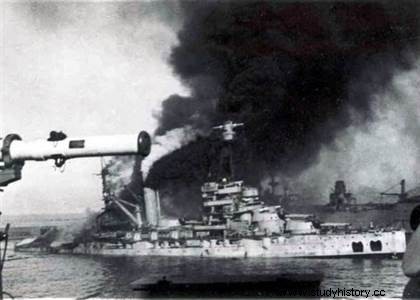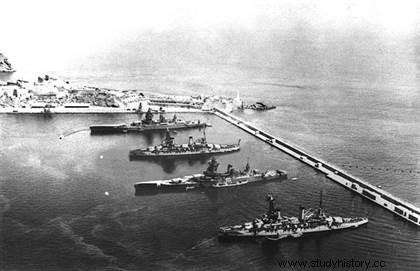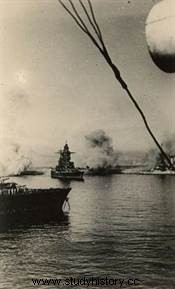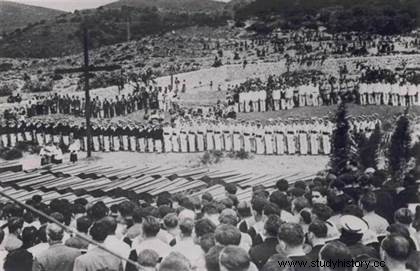 On July 3, 1940, the British navy attacked and destroyed a large part of the French fleet taking refuge in the harbor of Mers el-Kebir . In less than twenty minutes, the French ships trapped in the harbour, including three battleships, six destroyers and an aircraft carrier, were pounded and mostly sunk. During this operation, 1,297 French sailors were killed. Only the battleship Strasbourg and a small flotilla manage to set sail and reach the port of Toulon. The attack on Mers el-Kébir caused a wave of Anglophobia in France, relayed by the newspapers, contributing both to distance the Vichy government from Great Britain and to weaken for a time the action carried out by France free of General de Gaulle, who rallied to the English.
On July 3, 1940, the British navy attacked and destroyed a large part of the French fleet taking refuge in the harbor of Mers el-Kebir . In less than twenty minutes, the French ships trapped in the harbour, including three battleships, six destroyers and an aircraft carrier, were pounded and mostly sunk. During this operation, 1,297 French sailors were killed. Only the battleship Strasbourg and a small flotilla manage to set sail and reach the port of Toulon. The attack on Mers el-Kébir caused a wave of Anglophobia in France, relayed by the newspapers, contributing both to distance the Vichy government from Great Britain and to weaken for a time the action carried out by France free of General de Gaulle, who rallied to the English.
The reasons for the attack on Mers el-Kébir
The armistice agreement signed on June 22, 1940 between France and Germany providing for the return of French warships to their home port to be laid up, the English Prime Minister, Winston Churchill, fears that the French fleet will thus fall into the hands of the German army. On June 27, 1940, the Admiralty decided on measures aimed at preventing French ships from returning to France, even if it was to be laid up; the British government, in fact, does not trust Germany, which has made a commitment to Pétain not to use these ships for its own account.
Churchill orders Admiral Sommerville to leave Gibraltar at the head of a squadron, called "force H", to go to Mers el-Kébir, near Oran , where a large part of the ships of the French Navy found refuge. Vice-Admiral Sommerville's Force H is set up around the battlecruiser Hood (1), with Resolution battleships and Valiant , the aircraft carrier Ark Royal (2), two cruisers and several destroyers. Based in Gibraltar, its position is ideal for both monitoring the behavior of the French Navy and controlling the Italian Navy.

The 1 st July, Sommerville receives the order to obtain the transfer to British ports, or else the surrender or even the destruction of the French ships in the harbor of Mers el-Kébir, near Oran. On July 3, the French Admiral Gensoul found himself faced with four choices:to join the British fleet arriving off the port; depart with reduced crews for allied ports; disarm the ships of Mers el-Kébir under English control; scuttle them on the spot. Any other choice would lead to the attack of the port by the English buildings. However, in the British camp, this last option is far from unanimous, by attacking the Allies who recently fought alongside them; moreover, Sommerville knows that the French admirals are likely to take this kind of ultimatum very badly. He again asks his superiors for advice, which confirms his willingness to go all the way if necessary.
Indeed, the French reaction is icy:Admiral Gensoul refuses to receive Captain Holland aboard his flagship, the Dunkerque . At 10 a.m., the French replied to the message that he would not be the first to shoot, but that he would reply. Gensoul informs Darlan that his ships would probably be sunk in the next six hours, and at the same time issues the combat readiness orders.
The quarry
Admiral Gensoul is still trying to gain a few hours, while waiting for a reaction from Darlan. He finally receives Holland, who learns of Darlan's decision ten days earlier not to deliver the ships (to the Germans). In addition, Gensoul is indignant at the mining of the port started by the planes of the Ark Royal ! His hierarchy informed him after Holland's departure that, even if Darlan could not be reached, it had been decided to send the French naval forces in the region to lend him a hand against the British squadron. But this message is intercepted by the Admiralty who then urges Sommerville to settle the matter.
 The ultimatum is for 5:30 p.m., the English buildings open fire shortly before 6 p.m. French ships are hampered by their maneuvers to leave the harbour:the battleship Bretagne is hit first, it capsizes causing the death of 977 sailors! The Dunkirk is hit in turn, while the Provence manages to retaliate on the Hood , before having to run aground following a shell that failed to explode its ammunition hold. Destroyers, including the Mogador , were seriously damaged but the battlecruiser Strasbourg manages to escape on the high seas by hiding behind the smoke given off by the Bretagne . The fire ceased after a quarter of an hour, the British reluctant to spill more blood unnecessarily. The attack caused the death of 1,295 French sailors.
The ultimatum is for 5:30 p.m., the English buildings open fire shortly before 6 p.m. French ships are hampered by their maneuvers to leave the harbour:the battleship Bretagne is hit first, it capsizes causing the death of 977 sailors! The Dunkirk is hit in turn, while the Provence manages to retaliate on the Hood , before having to run aground following a shell that failed to explode its ammunition hold. Destroyers, including the Mogador , were seriously damaged but the battlecruiser Strasbourg manages to escape on the high seas by hiding behind the smoke given off by the Bretagne . The fire ceased after a quarter of an hour, the British reluctant to spill more blood unnecessarily. The attack caused the death of 1,295 French sailors.
The consequences of Mers El-Kébir
Admiral Sommerville did not expect to see a ship pass the mine barrage. Despite the cessation of fire on the harbour, he ordered the Swordfish of the Ark Royal to chase the Strasbourg , but without success. The French battlecruiser, but also the aircraft carrier Commandant-Teste , five destroyers and six cruisers from Algiers will reach Toulon on the evening of July 4.
 As Force H returns to Gibraltar, the neutralization of the French fleet continues. The attack on Mers el-Kébir coincides with the seizure of French ships already present in British ports; then, in Casablanca, the battleship Jean Bart , unfinished and which had left St Nazaire to escape the Germans, was spared. But its twin the Richelieu presents a much greater danger; it is anchored in Dakar and, despite damaged machinery, is fit for combat. On July 7, the aircraft carrier Hermes and two destroyers are sent to present him with the same ultimatum as in Oran. Same refusal. The British try to undermine the French battleship but fail, and then send their torpedo planes. A torpedo damages its hull, it will take a year to repair.
As Force H returns to Gibraltar, the neutralization of the French fleet continues. The attack on Mers el-Kébir coincides with the seizure of French ships already present in British ports; then, in Casablanca, the battleship Jean Bart , unfinished and which had left St Nazaire to escape the Germans, was spared. But its twin the Richelieu presents a much greater danger; it is anchored in Dakar and, despite damaged machinery, is fit for combat. On July 7, the aircraft carrier Hermes and two destroyers are sent to present him with the same ultimatum as in Oran. Same refusal. The British try to undermine the French battleship but fail, and then send their torpedo planes. A torpedo damages its hull, it will take a year to repair.
In Alexandria, a French squadron was integrated into Admiral Cunningham's Eastern Mediterranean Fleet. The latter reacted very badly to the order of his superiors to seize the ships of his allies at the very moment of the bombardment of Mers el-Kébir. After tough negotiations with Admiral Godfroy, Cunningham nevertheless managed to obtain the disarmament of the French ships without bloodshed on July 7, 1940.
The British government, by choosing force, took the risk of pushing the French into Hitler's arms. But Churchill could not risk leaving such a force intact without being assured that it would be allied to him. However, in the French camp, the bitterness is great:the example of Alexandria shows that with serious negotiation agreements could have been possible. The remaining French ships overseas were recalled to Toulon and the Germans allowed them to remain armed. The propaganda action of the collaborators was then facilitated, pointing out British baseness and the need to rally to the Axis.
The last stand of the Royal
These difficult blows did not prevent the French navy from experiencing new episodes of glory, albeit very different; first, two months later, the Richelieu (3) had his revenge:despite being immobilized in the port of Dakar, he almost single-handedly defeated the Anglo-Gaullist operation intended to take this strategic city! The British method is the same as in Oran, but the consequences are different. The ultimatum is clumsy and directs Governor General Boisson, who affirms his desire to defend Dakar to the end.
Cunningham's Squadron, consisting of battleships Barham and Resolution , of the aircraft carrier Ark Royal and several escort ships, opened fire on September 24, 1940 at 7 a.m. The damage committed was very insufficient, the 380 guns of the Richelieu keeping English ships at bay. Worse, the next day, the Resolution receives a torpedo from the submarine Bévéziers and will have to dry dock for several months in the United States! Half an hour later, it's the Barham (4) who suffers under the blows of the Richelieu ! This is too much for Cunningham, who orders the retreat... The main consequence of this defeat was a weakening of De Gaulle's rating in England...
 The other, more tragic event was of course the sinking of the French fleet in Toulon on November 27 1942...
The other, more tragic event was of course the sinking of the French fleet in Toulon on November 27 1942...
- (1) future victim of the Bismarck in May 1941.
- (2) it is his Swordfish that will cause the loss of the same Bismarck by damaging his rudder. She was herself torpedoed near Malta in November 1941 by a German submarine.
- (3) the Richelieu will know various adventures, including a participation in the end of the War of the Pacific.
- (4) the Barham, a veteran of the First World War like the Resolution, was sunk in the Mediterranean in November 1941 by U-331.
Bibliography
- F. DELPLA, Mers El Kébir July 3, 1940:England returns to war. Guibert, 2010.
- Mers El-Kebir July 1940, by Dominique Lormier. Calmann-Lévy, 2007.
- J.J. ANTIER, The great naval battles of the Second World War, volume 1, Omnibus, 2000.
